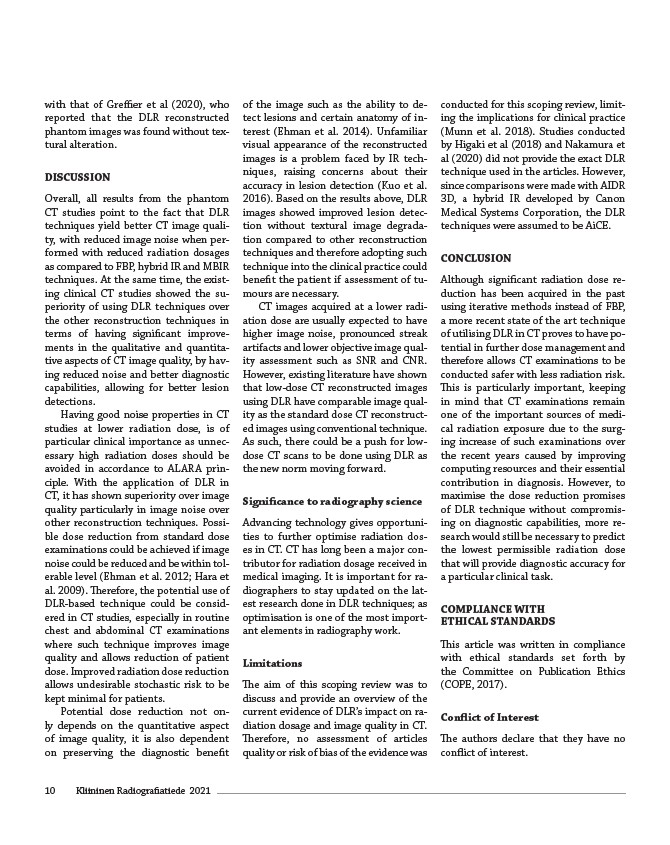
with that of Greffier et al (2020), who
reported that the DLR reconstructed
phantom images was found without tex-tural
alteration.
DISCUSSION
Overall, all results from the phantom
CT studies point to the fact that DLR
techniques yield better CT image quali-ty,
with reduced image noise when per-formed
with reduced radiation dosages
as compared to FBP, hybrid IR and MBIR
techniques. At the same time, the exist-ing
clinical CT studies showed the su-periority
of using DLR techniques over
the other reconstruction techniques in
terms of having significant improve-ments
in the qualitative and quantita-tive
aspects of CT image quality, by hav-ing
reduced noise and better diagnostic
capabilities, allowing for better lesion
detections.
Having good noise properties in CT
studies at lower radiation dose, is of
particular clinical importance as unnec-essary
high radiation doses should be
avoided in accordance to ALARA prin-
ciple. With the application of DLR in
CT, it has shown superiority over image
quality particularly in image noise over
other reconstruction techniques. Possi-ble
dose reduction from standard dose
examinations could be achieved if image
noise could be reduced and be within tol-erable
level (Ehman et al. 2012; Hara et
al. 2009). Therefore, the potential use of
DLR-based technique could be consid-ered
in CT studies, especially in routine
chest and abdominal CT examinations
where such technique improves image
quality and allows reduction of patient
dose. Improved radiation dose reduction
allows undesirable stochastic risk to be
kept minimal for patients.
Potential dose reduction not on-ly
depends on the quantitative aspect
of image quality, it is also dependent
on preserving the diagnostic benefit
10 Kliininen Radiografiatiede 2021
of the image such as the ability to de-tect
lesions and certain anatomy of in-terest
(Ehman et al. 2014). Unfamiliar
visual appearance of the reconstructed
images is a problem faced by IR tech-niques,
raising concerns about their
accuracy in lesion detection (Kuo et al.
2016). Based on the results above, DLR
images showed improved lesion detec-tion
without textural image degrada-tion
compared to other reconstruction
techniques and therefore adopting such
technique into the clinical practice could
benefit the patient if assessment of tu-mours
are necessary.
CT images acquired at a lower radi-ation
dose are usually expected to have
higher image noise, pronounced streak
artifacts and lower objective image qual-ity
assessment such as SNR and CNR.
However, existing literature have shown
that low-dose CT reconstructed images
using DLR have comparable image qual-ity
as the standard dose CT reconstruct-ed
images using conventional technique.
As such, there could be a push for low-dose
CT scans to be done using DLR as
the new norm moving forward.
Significance to radiography science
Advancing technology gives opportuni-ties
to further optimise radiation dos-es
in CT. CT has long been a major con-tributor
for radiation dosage received in
medical imaging. It is important for ra-diographers
to stay updated on the lat-est
research done in DLR techniques; as
optimisation is one of the most import-ant
elements in radiography work.
Limitations
The aim of this scoping review was to
discuss and provide an overview of the
current evidence of DLR’s impact on ra-diation
dosage and image quality in CT.
Therefore, no assessment of articles
quality or risk of bias of the evidence was
conducted for this scoping review, limit-ing
the implications for clinical practice
(Munn et al. 2018). Studies conducted
by Higaki et al (2018) and Nakamura et
al (2020) did not provide the exact DLR
technique used in the articles. However,
since comparisons were made with AIDR
3D, a hybrid IR developed by Canon
Medical Systems Corporation, the DLR
techniques were assumed to be AiCE.
CONCLUSION
Although significant radiation dose re-duction
has been acquired in the past
using iterative methods instead of FBP,
a more recent state of the art technique
of utilising DLR in CT proves to have po-tential
in further dose management and
therefore allows CT examinations to be
conducted safer with less radiation risk.
This is particularly important, keeping
in mind that CT examinations remain
one of the important sources of medi-cal
radiation exposure due to the surg-ing
increase of such examinations over
the recent years caused by improving
computing resources and their essential
contribution in diagnosis. However, to
maximise the dose reduction promises
of DLR technique without compromis-ing
on diagnostic capabilities, more re-search
would still be necessary to predict
the lowest permissible radiation dose
that will provide diagnostic accuracy for
a particular clinical task.
COMPLIANCE WITH
ETHICAL STANDARDS
This article was written in compliance
with ethical standards set forth by
the Committee on Publication Ethics
(COPE, 2017).
Conflict of Interest
The authors declare that they have no
conflict of interest.